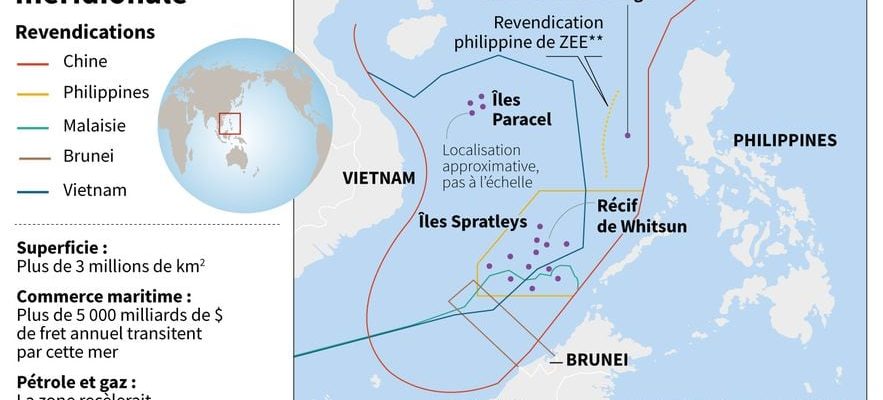Since the end of October, incidents have increased between China and the Philippines. China affirmed, Monday, December 11, that the operations carried out by its coast guard against Philippine ships in the South China Sea had been “professional” and “moderate”, and that it had “filed severe complaints” with Manila regarding the latest clashes.
These operations and these claims come after another turbulent weekend in the China Sea. A Philippine boat and a Chinese coast guard vessel collided Sunday near the Second Thomas Atoll in the waters of the Spratly Islands, claimed by China, with both countries blaming each other for the incident.
According to videos released by the Philippine Coast Guard, Chinese ships fired water cannons at Philippine boats during two separate resupply missions Saturday and Sunday, one of fishermen near the Scarborough Shoal Reef, and the other from a small garrison near Second Thomas Atoll. These confrontations are the most intense in recent years.
At the same time, the Philippines said on Sunday that a “swarm” of more than 135 Chinese boats was deployed around a reef that they claim, deeming this massive presence “alarming”. The Chinese boats are “scattered” around the Whitsun Reef, which the Philippines calls “Julian Felipe Reef”, about 320 kilometers west of the island of Palawan, according to the Philippine Coast Guard.
Escalation against a backdrop of ancient conflict
Manila and Beijing have a long history of maritime disputes in the South China Sea through which billions of dollars of goods pass each year. Beijing claims almost the entire South China Sea, including waters and islands near its neighbors’ coasts, and has ignored an international court’s ruling in 2016 rejecting the claim without legal basis. The Philippines, Brunei, Malaysia, Taiwan and Vietnam also claim several reefs and islets in this sea, some areas of which could contain rich oil reserves.
Disputed areas in the South China Sea
© / afp.com/
China took control of Scarborough Shoal in the Philippines in 2012. It has since deployed patrol boats that Manila says harass Filipino ships and prevent Filipino fishermen from reaching the lagoon where fish are more abundant. The reef is 240 kilometers west of the Philippines’ main island, Luzon, and nearly 900 kilometers from Hainan province, the nearest Chinese land. Under the 1982 United Nations Convention on the Law of the Sea, which China helped negotiate, countries have jurisdiction over natural resources within about 200 nautical miles (370 kilometers) of their coasts. .
China regularly deploys ships to patrol disputed waters and has built militarized artificial islands to strengthen its position. “I expect these situations to become even more frequent and persistent,” Jay Batongbacal, director of the Institute of Maritime Affairs and Law of the Sea at the University of the Philippines, told AFP.
On China’s side the situation is clear and responsibility lies entirely with Manila. “The root cause is that the Philippines broke its commitment by refusing to tow the illegally stranded military ship, attempting to bring in large-scale reinforcements and obtain permanent occupation,” said Mao Ning, spokesperson for the Philippines. Ministry of Foreign Affairs.
On Monday, diplomatic protests were sent and “the Chinese ambassador was also summoned,” Philippine Foreign Department spokeswoman Teresita Daza told reporters, adding that declaring the ambassador “persona non grata” from China Huang Xilian to the Philippines was also “something that needs to be seriously considered.” In a statement Sunday evening, President Ferdinand Marcos said the Philippines was “not discouraged” by the latest incidents. “No one, except the Philippines, has the legitimate right or legal basis to operate anywhere in the West Philippine Sea,” said Ferdinand Marcos, using the name the waters are commonly known as. South China Sea located immediately west of the Philippines.
Washington’s support for Manila exacerbates tensions
On Sunday, the United States, Manila’s military ally and former colonial power, called on China to “renounce its dangerous and destabilizing conduct” at sea, while foreign diplomats in Manila also criticized China’s behavior. “These actions reflect not only a reckless disregard for the safety and lives of Filipinos, but also for international law,” State Department spokesman Matthew Miller said in a statement. Song Zhongping, an analyst and former Chinese army officer, said Manila feels “emboldened to provoke China” by U.S. support that is escalating tensions.
“If the Philippines maintains this course and believes it can provoke China with the support of countries outside the region […] then a conflict or other eventuality could break out at Ren’ai Reef or Huangyan Island,” Mr. Song said, using the Chinese term for Second Thomas Atoll and Scarborough Shoal.
Philippine civilian supply boats returned to El Nido on the island of Palawan due to “constant surveillance of four Chinese ships, including two navy ships, one coast guard ship and a cargo ship”, indicated Atin Ito, ensuring that he had acted “as a precautionary measure” and “in consultation with the Philippine Coast Guard”. The “Christmas convoy”, which left Palawan in the early hours of Sunday, was led by dozens of volunteers on two boats carrying food, water and other donations.
As of 2021, some 210 Chinese ships had been stationed near Whitsun Reef for several weeks, according to the Philippine government. Beijing had claimed they were fishing boats sheltering from bad weather, but Manila rejected this explanation, saying there had been no storms during the relevant period.
